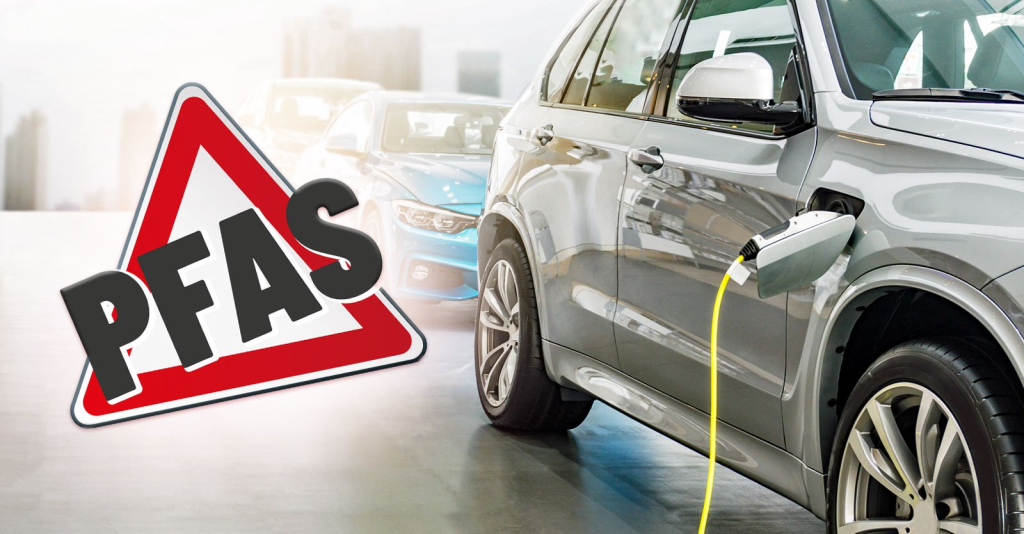
Please Follow us on Gab, Minds, Telegram, Rumble, Gettr, Truth Social, Twitter
A type of toxic per- and polyfluoroalkyl substances (PFAS) in lithium-ion batteries that power electric vehicles and other electronics is polluting air, soil and water in the U.S. and Europe, adding to concerns that the growing clean energy sector could harm the environment even as it strives to combat climate change, according to a new study.
Researchers said they analyzed samples of soil, sediment and surface water collected in 2022 near manufacturing plants in Minnesota, Kentucky, Belgium and France, finding they were commonly contaminated with a subtype of PFAS called bis-perfluoroalkyl sulfonimides (bis-FASIs) at concentrations in the parts per billion.
The study, published Monday in the journal Nature Communications, also found that bis-FASI emitted into the air at these sites may travel long distances, potentially polluting areas far from the facilities where they are made and used.
“If we are not careful about the choices of materials and chemicals used in renewable energy technologies, then it is a concern that this may become a new source of PFAS pollution,” said Ariana Spentzos, Ph.D., a science and policy associate at the Green Science Policy Institute. Spentzos was not involved in the study.
“However, it is a false choice to choose between renewable energy and less PFAS pollution,” she added, noting that there are viable alternatives for many uses of PFAS in renewable energy.
Bis-FASIs, particularly the chemical bistriflimide, are manufactured by major chemical companies, including 3M and Solvay, and marketed as electrolytes that extend battery cycle life and maintain battery performance over time.
Many types of PFAS, known as “forever chemicals” because they don’t break down in the environment, are used in the coatings on windmill turbines and are incorporated into solar cells, as well as being used in lithium-ion batteries.
But PFAS pollution is not just a concern with sustainable energy technologies — the oil and gas industry has used PFAS chemicals for decades, including in fracking operations across the country.
A 2023 report by the U.S. Environmental Protection Agency (EPA) reviewed the small handful of existing studies on bis-FASIs, noting that studies have reported liver effects in rats after they were exposed to the chemicals.
Although the toxicity of bis-FASI in humans has not been studied, other types of PFAS have been linked to cancers, infertility and immune system damage.
The EPA in April set a limit of four parts per trillion for perfluorooctanoic acid (PFOA) and perfluorooctanesulfonic acid, or PFOS, in drinking water and 10 parts per trillion for several others.
Bis-FASIs are toxic to two types of small aquatic animals, a crustacean and zebrafish, altering their behavior and metabolic processes, the study found.
Similar to better-studied types of PFAS that have been phased out, bis-FASIs do not appear to break down naturally in the environment, said Lee Ferguson, associate professor of civil and environmental engineering at Duke University and an author of the study.
The researchers also analyzed samples from untreated landfill leachate in North Carolina, finding bistriflimide at levels close to 1 part per billion — a concentration that Ferguson said he considered surprisingly high.
“Some of the data we showed in the paper indicates that measurements of bistriflimide in landfill leachates may be coming from disposal of these lithium-ion batteries,” said Ferguson. “We really need to pay attention, if we are going to use materials that are very persistent, to what happens to them at end of life.”
As clean energy production gains traction, now is society’s chance to evaluate environmental risks and avoid a “regrettable substitution” on the path toward more sustainable infrastructure, said Jennifer Guelfo, Ph.D., an assistant professor of environmental engineering at Texas Tech University and an author of the study.
“We’re seeing manufacturing releases [with bis-FASIs] just like we’ve seen with PFOA,” said Guelfo. “Let’s not repeat the past.”
Originally published by The New Lede.
Shannon Kelleher is a reporter for The New Lede.
“© [2024] Children’s Health Defense, Inc. This work is reproduced and distributed with the permission of Children’s Health Defense, Inc. Want to learn more from Children’s Health Defense? Sign up for free news and updates from Robert F. Kennedy, Jr. and the Children’s Health Defense. Your donation will help to support us in our efforts.

"Climate Change" - GMAFB